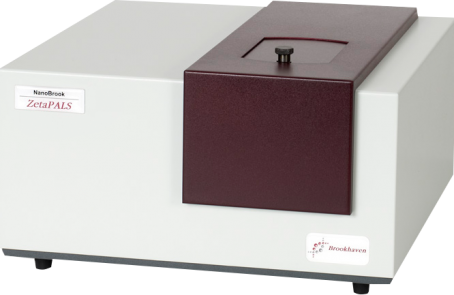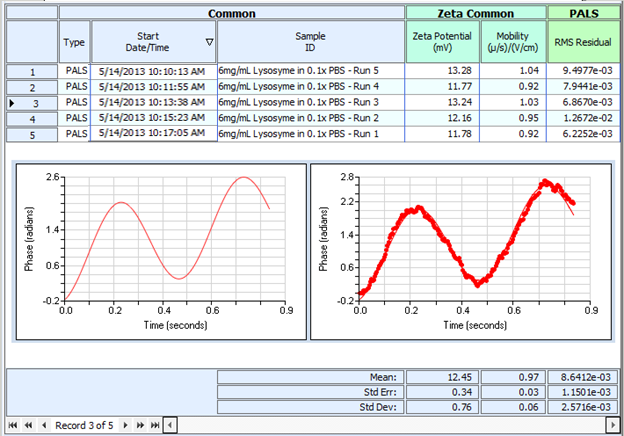
Features at a glance
- Zeta potential for the difficult cases
- For proteins, peptides, mAb, RNA, and other biological samples
- For zeta potential in organic solvents
- For oily or viscous media
- For high-salt suspensions
- For samples near the I.E.P.
- 1,000 times more sensitive than other techniques
- Disposable cuvettes, no contamination or alignment
- Built in automatic procedures and parameters (SOP)
- Easy to use
A whole new concept...
Unique to Brookhaven! For the difficult cases
For measurements of very low mobilities, the NanoBrook ZetaPALS is the answer. The only answer! With concepts developed at Bristol University and Brookhaven Instruments, the NanoBrook ZetaPALS determines zeta potential using Phase Analysis Light Scattering: A technique that is up to 1,000 times more sensitive than traditional light scattering methods based on the shifted frequency spectrum.
Electrostatic repulsion of colloidal particles is often the key to understanding the stability of any dispersion. A simple, easy measurement of the electrophoretic mobility "even in nonpolar liquids" yields valuable information. Measurements made in water and other polar liquids are easy and fast with the NanoBrook ZetaPlus. Such measurements cover the range of typically ± (6 to 100) mV, corresponding to mobilities of ± 0.5-8x10-8 m2 /V·s. The NanoBrook ZetaPALS covers this full range, of course, and extends it by a factor of 1000 in sensitivity!
Principles of Operation
The NanoBrook ZetaPALS utilizes phase analysis light scattering to determine the electrophoretic mobility of charged, colloidal suspensions. Unlike its cousin, Laser Doppler Velocimetry (LDV) (sometimes called Laser Doppler Electrophoresis (LDE)), the PALS technique does not require the application of large fields which may result in thermal problems or denaturation. This is due to the fact that the measurement analyzes the phase shift. The particles need only to move a fraction of their own diameter to yield good results. In salt concentrations up to 2 molar and with electric fields as small as 1 or 2 V/cm enough movement is induced to get excellent results. In addition, the Autotracking feature compensates for thermal drift.

Figure 1
Simple Clear Presentation
Figure 1 above shows the results of an actual experiment with a NanoBrook ZetaPALS instrument. The important parameters and results are seen at a glance. The excellent agreement of the five runs in this experiment is obvious as is the match of expermental curve (red, bold) and it's fitted version (red, thin). As with all Brookhaven instruments the user can simply produce a customized report.
Multiple Sample Types
Table 1 below shows a variety of difficult to measure samples, all of which were easily measured with the NanoBrook ZetaPALS. Some were measured in high salt concentration; some in low dielectric constant non-polar solvents; and one in a viscous liquid.
Electrophoretic Mobilities Determined with the NanoBrook ZetaPALS
(units 10-8 m2 /V·s) |
| Sample |
PALS Result |
Lit. Value |
Comments |
| NIST 1980 |
2.51 ± 0.11 |
2.53 ± 0.12 |
Electrophoretic mobility standard. |
| Blood Cells |
-1.081 ± 0.015 |
-1.08 ± 0.02 |
Dispersed in physiological saline |
| Fe2O3 |
0.013 ± 0.0015 |
N.A. |
Dispersed in dodecane |
| TiO2 |
0.255 ± 0.010 |
N.A. |
Dispersed in toluene - not dried |
| TiO2 |
0.155 ± 0.011 |
N.A. |
Dispersed in toluene - dried |
| TiO2 |
-0.503 ± 0.015 |
N.A. |
Dispersed in ethanol |
| Casein |
-0.025 ± 0.002 |
N.A. |
Dispersed in PEG - viscous |
| SiO2 |
-0.73 ± 0.04 |
N.A. |
Dispersed in 2.0 M KCl - High salt |
Custom Columns
The software can be easily customized to display the columns needed for a quick review of the important parameters as shown below

Figure 2
Something More Challenging
Of course the NanoBrook ZetaPALS can quickly and easily yield results from all "regular" samples but its real strength is in the difficult cases and to demonstrate the performance of this premium instrument where others fail, we offer the following table:
Biological samples such as proteins, antibodies, peptides, DNA/RNA are easily denatured by electrical fields. The NanoBrook ZetaPALS can successfully measure the mobility of biological samples with typical voltages from 2 to 4 Volts. In Figure 1 above, Lysozyme was measured with 2.5 Volts applied.
Aggressive Solventssuch as DMF, THF, DMSO, MET, etc. are easily accomodated by Brookhaven's NanoBrook ZetaPALS system with the use of our special solvent resistant electrodes and glass sample cells. The extension of zeta potential measurements into the realm of such systems is just another standout property of the NanoBrook ZetaPALS. Some examples of this are shown in Table 1.
High salt concentrations difficult to measure due to the Joule heating and energy dissipated. The power applied in high salt has to be kept low in order to avoid affecting the sample. Only Brookhaven's NanoBrook ZetaPALS can measure in salt conditions up to 2 Molar. An example is shown in Table 1.
Unusual solvent? If your solvent is unusual then it's dielectric constant is probably unknown. In thise case our BI-870 Dielectric Constant Meter will quickly, easily, and accurately provide the information necessary for a zeta potential determination.


 (028) 22 611 711
(028) 22 611 711
 Danh mục
Danh mục
 High Purity Northwest Inc.
High Purity Northwest Inc.
 Phóng Điện Cục Bộ
Phóng Điện Cục Bộ





























 Gọi điện
Gọi điện SMS
SMS Chỉ Đường
Chỉ Đường